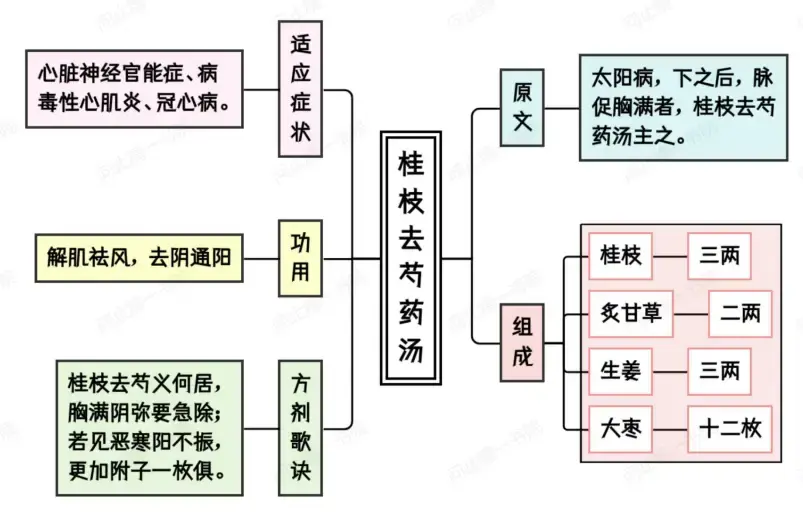Gui Zhi Qu Shao Yao Tang: Warming the Chest and Relieving Fullness in Traditional Chinese Medicine
- Health Lab

- Jun 2
- 3 min read
Updated: Jun 13
In the vast realm of Traditional Chinese Medicine (TCM), Gui Zhi Tang (Cinnamon Twig Decoction) and its variations hold a significant place. Gui Zhi Qu Shao Yao Tang, a variant of Gui Zhi Tang, omits the herb peony (Shao Yao), resulting in a formula with distinct therapeutic applications.
Despite its simplicity, this formula excels in treating chest fullness caused by improper treatment of exterior syndromes, offering unique benefits rooted in TCM principles.
Originating from Zhang Zhongjing’s Shanghan Zabing Lun (Treatise on Cold Damage and Miscellaneous Diseases) in the Eastern Han Dynasty, Gui Zhi Qu Shao Yao Tang is designed to address chest yang deficiency and internal trapping of pathogenic factors following the mistreatment of Taiyang (Greater Yang) syndromes. This classic text, later divided into Shanghan Lun and Jin Gui Yao Lue, laid the foundation for TCM’s syndrome differentiation and treatment.

Understanding Gui Zhi Qu Shao Yao Tang
Composition and Roles of Herbs
Gui Zhi Qu Shao Yao Tang is derived from Gui Zhi Tang by removing peony, leaving four herbs structured according to the TCM principle of "monarch, minister, assistant, and envoy":
Monarch Herb: Cinnamon Twig (Gui Zhi)
Warm and pungent, it warms the channels, disperses cold, and promotes yang qi, revitalizing chest yang and expelling cold pathogens.
Minister Herb: Fresh Ginger (Sheng Jiang)
Pungent and warm, it warms the middle, disperses cold, and supports yang transformation, enhancing Gui Zhi’s warming effects.
Assistant Herb: Chinese Date (Da Zao)
Sweet and warm, it tonifies the middle, boosts qi, nourishes blood, and calms the spirit, supporting the spleen and stomach to prevent yang herbs from depleting vital energy.
Envoy Herb: Licorice Root (Gan Cao)
Sweet and neutral, it harmonizes the formula, tonifies qi, and supports the spleen, aiding the other herbs’ actions.
Formula Analysis
Gui Zhi Tang balances yin and yang with two groups of herbs: pungent-sweet herbs (yang) and sour-sweet herbs (yin). By removing peony, a yin-nourishing herb, Gui Zhi Qu Shao Yao Tang focuses solely on yang herbs, making it ideal for invigorating chest yang and relieving chest fullness.
Pathological Mechanism
Gui Zhi Qu Shao Yao Tang targets specific pathological conditions:
Internal Trapping of Pathogens: In Taiyang syndromes, pathogens reside on the body’s surface and should be expelled through sweating. Mistreatment with purgative methods weakens vital qi, allowing pathogens to invade deeper, entering the chest.
Chest Yang Deficiency: Chest yang warms organs and drives qi and blood flow. When pathogens trap in the chest, they obstruct yang qi, causing chest yang deficiency and symptoms like chest fullness or palpitations.
Qi Stagnation: Obstructed yang qi leads to qi stagnation, impairing blood and qi flow in the chest, resulting in fullness, discomfort, or pain. A rapid, choppy pulse often accompanies this stagnation.

Indications and Benefits
Gui Zhi Qu Shao Yao Tang is primarily used for chest yang deficiency due to mistreatment of Taiyang syndromes, with symptoms including:
Rapid, Choppy Pulse: A fast but weak and irregular pulse.
Chest Fullness: A sensation of stuffiness or discomfort in the chest, sometimes extending to the ribs or stomach.
As recorded in Shanghan Lun: “In Taiyang disease, if purgation is mistakenly used, resulting in a rapid pulse and chest fullness, Gui Zhi Qu Shao Yao Tang is indicated.”
Main Functions
Warms Yang and Disperses Cold: Restores chest yang, expels cold pathogens, and promotes smooth qi flow.
Relieves Chest Fullness: Eases discomfort and stuffiness in the chest.
Modern Applications
While research on Gui Zhi Qu Shao Yao Tang is limited, its clinical applications align with TCM principles:
Angina Pectoris: Relieves chest pain due to heart yang deficiency by warming heart yang and improving blood flow.
Pleurisy: Addresses chest fullness and coughing caused by yang deficiency and fluid retention by warming yang and transforming fluids.
Other Conditions: May be used for chest pain, palpitations, or breathing difficulties due to chest yang deficiency, based on proper syndrome differentiation.
Precautions for Use
Syndrome Differentiation: This formula is specific to chest yang deficiency with rapid pulse and chest fullness. It is unsuitable for other syndromes.
Contraindications: Use cautiously in cases of yin deficiency with internal heat, as the warming nature may exacerbate symptoms.
Pregnancy: Pregnant women should consult a TCM practitioner before use.
Dietary Considerations: During treatment, maintain a light diet and avoid cold, greasy foods to support the formula’s effects.
Conclusion
Gui Zhi Qu Shao Yao Tang, a refined variation of Gui Zhi Tang, showcases the precision of TCM in addressing chest yang deficiency and fullness caused by mistreatment. Its simple yet effective blend of herbs warms yang, disperses cold, and restores smooth qi flow. By understanding its composition, indications, and modern applications, we can appreciate its enduring value in TCM. Always consult a qualified practitioner to ensure safe and effective use tailored to individual conditions.



Comments